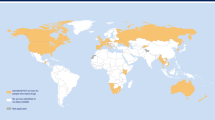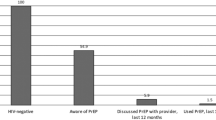Abstract
Injection drug use is a key risk factor for the transmission of HIV. Prevention strategies, such as the use of pre-exposure prophylaxis (PrEP), are effective at reducing the risk of HIV transmission in people who inject drugs (PWID). Following PRISMA guidelines, a literature search was conducted to identify the current state of the PrEP care cascade in PWID. Twenty-three articles were evaluated in this systematic review. A decline in engagement throughout the stages of the PrEP care cascade was found. High awareness and willingness to use PrEP was found, yet PrEP uptake was relatively low (0–3%). There is a lack of research on interventions to increase engagement of PrEP across all levels of the care cascade in PWID. Implications from the interventions that have been published provide insight into practice and public policy on efficacious strategies to reduce HIV incidence in PWID. Our findings suggest that more efforts are needed to identify and screen PWID for PrEP eligibility and to link and maintain them with appropriate PrEP care.

Similar content being viewed by others
References
Centers for Disease Control and Prevention. Persons who inject drugs (PWID). https://www.cdc.gov/pwid/index.html (2018). Accessed 14 May 2020.
Centers for Disease Control and Prevention. Injection drug use. https://www.cdc.gov/hiv/risk/drugs/index.html (2019). Accessed 10 Feb 2020
Kral AH, et al. HIV prevalence and risk behaviors among men who have sex with men and inject drugs in San Francisco. J Urban Health. 2005;82(1):i43–50.
Green TC, et al. HIV infection and risk of overdose: a systematic review and meta-analysis. Aids. 2012;26(4):403–17.
Volkow ND, Montaner J. The urgency of providing comprehensive and integrated treatment for substance abusers with HIV. Health Aff (Millwood). 2011;30(8):1411–9.
Alpren C, et al. Opioid use fueling HIV transmission in an urban setting: an outbreak of HIV infection among people who inject drugs-massachusetts, 2015-2018. Am J Public Health. 2020;110(1):37–44.
Larney S, et al. Global, regional, and country-level coverage of interventions to prevent and manage HIV and hepatitis C among people who inject drugs: a systematic review. Lancet Glob Health. 2017;5(12):e1208–20.
Substance Abuse and Mental Health Services Administration. Medicaid coverage of medication-assisted treatment for alcohol and opioid use disorders and of medication for the reversal of opioid overdose. Rockville, MD: Substance Abuse and Mental Health Services Administration; 2018.
Priest KC, et al. Comparing Canadian and United States opioid agonist therapy policies. Int J Drug Policy. 2019.
The Foundation for AIDS Research. Toward an effective strategy to combat HIV, hepatitis c and the opioid epidemic: recommendations for policy makers. Washington, DC; 2019.
Centers for Disease Control and Prevention. Prevention. https://www.cdc.gov/hiv/basics/prevention.html (2019). Accessed 23 May 2020
Centers for Disease Control and Prevention. PreExposure prophlyaxis for the prevention of HIV infection in the United States. https://www.cdc.gov/hiv/pdf/risk/prep/cdc-hiv-prep-guidelines-2017.pdf (2017). Accessed 11 Feb 2020
Choopanya K, et al. Antiretroviral prophylaxis for HIV infection in injecting drug users in Bangkok, Thailand (the Bangkok Tenofovir Study): a randomised, double-blind, placebo-controlled phase 3 trial. Lancet. 2013;381(9883):2083–90.
National Institute of Mental Health. Improving the HIV pre-exposure prophylaxis (PrEP) cascade. https://www.nimh.nih.gov/funding/grant-writing-and-application-process/concept-clearances/2015/improving-the-hiv-pre-exposure-prophylaxis-prep-cascade.shtml (2015). Accessed 10 Feb 2020
Closson EF, et al. Exploring strategies for PrEP adherence and dosing preferences in the context of sexualized recreational drug use among MSM: a qualitative study. AIDS Care. 2018;30(2):191–8.
Oldenburg CE, et al. Differences in attitudes about HIV pre-exposure prophylaxis use among stimulant versus alcohol using men who have sex with men. AIDS Behav. 2016;20(7):1451–60.
Storholm ED, et al. Risk perception, sexual behaviors, and PrEP adherence among substance-using men who have sex with men: a qualitative study. Prev Sci. 2017;18(6):737–47.
Wade Taylor S, et al. Optimizing content for pre-exposure prophylaxis (PrEP) counseling for men who have sex with men: perspectives of PrEP users and high-risk PrEP naive men. AIDS Behav. 2014;18(5):871–9.
Walters SM, et al. Differences in awareness of pre-exposure prophylaxis and post-exposure prophylaxis among groups at-risk for HIV in New York State: New York City and Long Island, NY, 2011-2013. J Acquir Immune Defic Syndr. 2017;75(Suppl 3):S383–91.
Footer KHA, et al. Exploring new and existing PrEP modalities among female sex workers and women who inject drugs in a U.S. city. AIDS Care. 2019;31(10):1207–13.
Peitzmeier SM, et al. Acceptability of microbicidal vaginal rings and oral pre-exposure prophylaxis for HIV prevention among female sex workers in a high-prevalence US city. AIDS Care. 2017;29(11):1453–7.
Biello KB, et al. Perspectives on HIV pre-exposure prophylaxis (PrEP) utilization and related intervention needs among people who inject drugs. Harm Reduct J. 2018;15(1):55.
Sophus AI, Mitchell JW. A review of approaches used to increase awareness of pre-exposure prophylaxis (PrEP) in the United States. AIDS Behav. 2019;23(7):1749–70
Stein M, Thurmond P, Bailey G. Willingness to use HIV pre-exposure prophylaxis among opiate users. AIDS Behav. 2014;18(9):1694–700.
Khawcharoenporn T, Kendrick S, Smith K. HIV risk perception and preexposure prophylaxis interest among a heterosexual population visiting a sexually transmitted infection clinic. AIDS Patient Care STDS. 2012;26(4):222–33.
Zhang C, et al. Suboptimal HIV pre-exposure prophylaxis awareness and willingness to use among women who use drugs in the united states: a systematic review and meta-analysis. AIDS Behav. 2019;23(10):2641–53.
Allen ST, et al. Barriers and facilitators to PrEP use among people who inject drugs in rural appalachia: a qualitative study. AIDS Behav. 2019.
Bazzi AR, et al. Limited knowledge and mixed interest in pre-exposure prophylaxis for HIV prevention among people who inject drugs. AIDS Patient Care STDS. 2018;32(12):529–37.
Roth AM, et al. An exploration of factors impacting preexposure prophylaxis eligibility and access among syringe exchange users. Sex Transm Dis. 2018;45(4):217–21.
Shrestha R, et al. Developing an integrated, brief biobehavioral HIV prevention intervention for high-risk drug users in treatment: the process and outcome of formative research. Front Immunol. 2017;8:561.
Shrestha R, Copenhaver M. Exploring the use of pre-exposure prophylaxis (PrEP) for HIV prevention among high-risk people who use drugs in treatment. Front Public Health. 2018;6:195.
Jo Y, et al. Interest in linkage to PrEP among people who inject drugs accessing syringe services; Miami, Florida. PLoS ONE. 2020;15(4):e0231424.
Felsher M, et al. An exploration of pre-exposure prophylaxis (PrEP) initiation among women who inject drugs. Arch Sex Behav. 2020.
Walters SM, et al. Awareness of pre-exposure prophylaxis (PrEP) among women who inject drugs in NYC: the importance of networks and syringe exchange programs for HIV prevention. Harm Reduct J. 2017;14(1):40.
Kuo I, et al. Willingness to use HIV pre-exposure prophylaxis among community-recruited, older people who inject drugs in Washington, DC. Drug Alcohol Depend. 2016;164:8–13.
Sherman SG, et al. PrEP awareness, eligibility, and interest among people who inject drugs in Baltimore, Maryland. Drug Alcohol Depend. 2019;195:148–55.
Metz VE, et al. Racial differences in HIV and HCV risk behaviors, transmission, and prevention knowledge among non-treatment-seeking individuals with opioid use disorder. J Psychoactive Drugs. 2017;49(1):59–68.
Roth A, et al. Factors associated with awareness of pre-exposure prophylaxis for HIV among persons who inject drugs in philadelphia: national HIV behavioral surveillance, 2015. AIDS Behav. 2019;23(7):1833–40.
Shrestha R, et al. Willingness to use pre-exposure prophylaxis (PrEP): an empirical test of the information-motivation-behavioral skills (IMB) model among high-risk drug users in treatment. AIDS Behav. 2017;21(5):1299–308.
Shrestha R, et al. Integrated bio-behavioral approach to improve adherence to pre-exposure prophylaxis and reduce HIV risk in people who use drugs: a pilot feasibility study. AIDS Behav. 2018;22(8):2640–9.
Shrestha R, et al. Measuring acceptability and preferences for implementation of pre-exposure prophylaxis (PrEP) using conjoint analysis: an application to primary HIV prevention among high risk drug users. AIDS Behav. 2018;22(4):1228–38.
Shrestha R, et al. Correlates of willingness to initiate pre-exposure prophylaxis and anticipation of practicing safer drug- and sex-related behaviors among high-risk drug users on methadone treatment. Drug Alcohol Depend. 2017;173:107–16.
Shrestha R, et al. Intent to use preexposure prophylaxis (PrEP), HIV risk behaviors, and self-report neurocognitive symptoms by high-risk drug users: a mediation analysis. J Assoc Nurses AIDS Care. 2017;28(4):612–21.
McFarland W, et al. Low PrEP awareness and use among people who inject drugs, San Francisco, 2018. AIDS Behav. 2019.
Gunstad, J., et al. Cluster analysis of data from the brief inventory of neurocognitive impairment (BINI) to develop neuro-cognitive profiles among opioid-dependent patients in drug treatment. Substance Abuse
Earnshaw VA, et al. Intersectionality of internalized HIV stigma and internalized substance use stigma: implications for depressive symptoms. J Health Psychol. 2015;20(8):1083–9.
Centers for Disease Control and Prevention. Changes in HIV preexposure prophylaxis awareness and use among men who have sex with men. https://www.cdc.gov/mmwr/volumes/68/wr/mm6827a1.htm (2019). Accessed 23 Mar 2020
Remy L, Enriquez M. Behavioral interventions to enhance PrEP uptake among black men who have sex with men: a review. J Assoc Nurses AIDS Care. 2019;30(2):151–63.
Centers for Disease Control and Prevention. Access to clean syringes. https://www.cdc.gov/policy/hst/hi5/cleansyringes/index.html (2016). Accessed 23 May 2020
Chadwick JJ, et al. Correlates of having never been HIV tested among entrants to substance abuse treatment clinics: empiric findings from real-world New England settings. J Psychoactive Drugs. 2014;46(3):208–14.
Metsch LR, et al. Implementing rapid HIV testing with or without risk-reduction counseling in drug treatment centers: results of a randomized trial. Am J Public Health. 2012;102(6):1160–7.
National Institute of Mental Health. Integrated care. 2017. https://www.nimh.nih.gov/health/topics/integrated-care/index.shtml#:~:text=Providing%20Integrated%20Care%20helps%20patients,offered%20in%20the%20same%20setting. Accessed 12 Jul 2020
Remien RH, et al. Mental health and HIV/AIDS: the need for an integrated response. AIDS (Lond.). 2019;33(9):1411–20.
Dunlop DD, et al. Racial/ethnic differences in rates of depression among preretirement adults. Am J Public Health. 2003;93(11):1945–52.
National Institute on Drug Abuse. Comorbidity: substance use disorders and other mental illnesses. 2018. https://www.drugabuse.gov/publications/drugfacts/comorbidity-substance-use-disorders-other-mental-illnesses. Accessed 21 Apr 2020
Rich KM, et al. Integrated models of care for individuals with opioid use disorder: how do we prevent HIV and HCV? Curr HIV/AIDS Rep. 2018;15(3):266–75.
Molina JM, et al. Efficacy, safety, and effect on sexual behaviour of on-demand pre-exposure prophylaxis for HIV in men who have sex with men: an observational cohort study. Lancet HIV. 2017;4(9):e402–10.
U.S. Department of Health & Human Services. Long-acting HIV prevention tools. https://www.hiv.gov/hiv-basics/hiv-prevention/potential-future-options/long-acting-prep (2019). Accessed 19 Feb 2020
Kelley CF, et al. Applying a PrEP continuum of care for men who have sex with men in Atlanta, Georgia. Clin Infect Dis. 2015;61(10):1590–7.
Wilton J, et al. Use of an HIV-risk screening tool to identify optimal candidates for PrEP scale-up among men who have sex with men in Toronto, Canada: disconnect between objective and subjective HIV risk. J Int AIDS Soc. 2016;19(1):20777.
Funding
This work was supported by grants from the National Institute on Drug Abuse (K01DA051346 for RS and K24DA051344 for MMC) and grant from the National Institute of Mental Health (5T32MH074387-14 for CBM).
Author information
Authors and Affiliations
Corresponding author
Ethics declarations
Conflict of interest
The authors have no conflicts of interest to disclose.
Research Involving in Human and Animal Rights
No human or animal subjects were asked to participate for this review.
Additional information
Publisher's Note
Springer Nature remains neutral with regard to jurisdictional claims in published maps and institutional affiliations.
Rights and permissions
About this article
Cite this article
Mistler, C.B., Copenhaver, M.M. & Shrestha, R. The Pre-exposure Prophylaxis (PrEP) Care Cascade in People Who Inject Drugs: A Systematic Review. AIDS Behav 25, 1490–1506 (2021). https://doi.org/10.1007/s10461-020-02988-x
Published:
Issue Date:
DOI: https://doi.org/10.1007/s10461-020-02988-x




